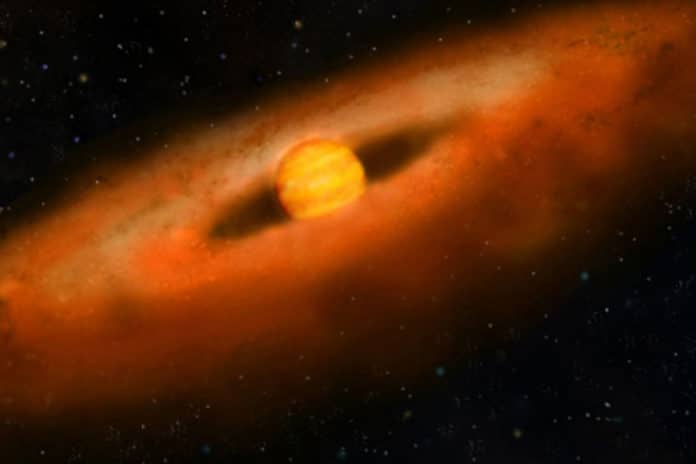A brown dwarf is a substellar object with a mass between those of the heaviest gas giant planets and the least massive stars. They are considered as the missing link between the largest gas giant planets and the smallest stars, because of their relative dim glow.
Like stars, some brown dwarfs can retain the disk of swirling gas and dust left over from their initial formation. This material can collide and accumulate to form planets, though it’s unclear exactly what kind of planets brown dwarfs can generate.
Recently, scientists MIT, the University of Oklahoma, and elsewhere, with the help of citizen scientists, have detected a closest young brown dwarf disk yet within about 100 parsecs of Earth. Dubbed as W1200-7845, the brown dwarf has a disk that could potentially form planets. It is about 3.7 million years old and lies nearly 102 parsecs or about 332 light-years from Earth.
The new system was discovered through Disk Detective, a crowdsourced project funded by NASA and hosted by Zooniverse that provides images of objects in space for the public to classify, to pick out objects that are likely stars with disks that could potentially host planets.
Study co-author Steven Silverberg, a postdoc in MIT’s Kavli Institute for Astrophysics and Space Research said, “We have multiple citizen scientists look at each object and give their own independent opinion, and trust the wisdom of the crowd to decide what things are probably galaxies and what things are probably stars with disks around them.”
“From there, a science team including Silverberg follows up on crowd-classified disks, using more sophisticated methods and telescopes to determine if indeed they are disks, and what characteristics the disks may have.”
In the case of the newly discovered W1200-7845, citizen scientists first classified the object as a disk in 2016. Scientists, then using an infrared instrument on the Magellan 6.5-meter telescopes at Las Campanas Observatory in Chile, took a closer look at the object.
With these new observations, they determined that the source was indeed a disk around a brown dwarf.
Silverberg said, “A disk’s mass tells you how much stuff is in the disk, which would tell us if planet formation happens around these systems, and what sorts of planets you’d be able to produce. You could also use that data to determine what kinds of gas are in the system, which would tell you about the disk’s composition.”
The team plans to zoom further in on W1200-7845 with other telescopes, such as ALMA, the Atacama Large Millimeter Array in Chile, comprising 66 huge radio dishes that work together as one powerful telescope to observe the universe between the radio and infrared bands. At this range and precision, the researchers hope to see the brown dwarf’s disk itself, to measure its mass and radius.
Scientists are presenting their findings, as well as announcing a new version of the Disk Detective website, this week at the all-virtual meeting of the American Astronomical Society.
